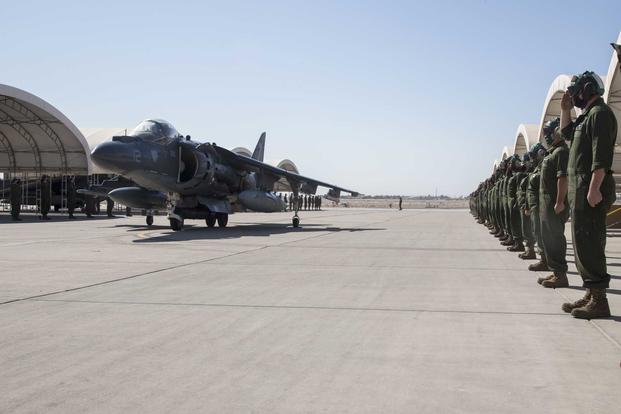The Marine Corps is saying goodbye to one of its historic AV-8B Harrier squadrons as it transitions to fly the F-35B Lightning II stealth fighter.
The service last week held a "sunset ceremony" for Marine Attack Squadron 311 at Marine Corps Air Station Yuma, Arizona, according to a news release.
VMA-311 will merge with the VMA-214 "Black Sheep," another Harrier squadron, next spring to form "Marine Fighter Attack Squadron 311" at MCAS Miramar, California, in preparation to fly the Joint Strike Fighter, the release states.
Read Next: Gabbard Leaves Hawaii National Guard for California Unit
Known as the "Tomcats," VMA-311 began at Cherry Point, North Carolina, in 1942 as a training unit and quickly transitioned into a combat unit to fly the F4U Corsair in the Pacific during World War II. Operating out of Okinawa in 1945, it was the first Marine squadron to use fighter aircraft "for dive bombing missions," according to the unit's history webpage.
In 1948, the Tomcats were the first Marine Corps unit to receive jet aircraft -- the F-80A Shooting Star, followed by the F9F2 Panther, the history page states. The squadron scored another milestone in 1950 during the Korean War as it flew the first Marine combat mission, providing close-air support to Army units operating near the Chosin Reservoir. Pilots from VMA-311 racked up more than 18,851 combat sorties over two years during the conflict, per the unit's page.
History making didn't stop there. VMA-311 was the first Marine squadron "to employ the AV-8B Harrier in combat during Operation Desert Shield," the release adds.
"VMA-311's Harriers were the first to fly combat missions in Afghanistan during Operation Enduring Freedom, and participated in the first combat sortie of Operation Iraqi Freedom in 2003. With a longstanding tradition of aviation firsts, VMA-311 remained an integral force in the nation's forward presence around the globe," the release states.
"The reputable Tomcats have an exceptional level of esprit de corps representing 78 years of superior performance," said Sgt. Maj. Colin Barry, VMA-311's top enlisted leader. "The Tomcats imbued a level of morale within each other that was unmatched, but I have no doubt the newly adopted VMA-214 Black Sheep identity will be embraced, and they will continue performing remarkably."
Officials note that the transition to the F-35B variant -- a vertical takeoff and landing platform like the Harrier -- represents the future of aviation for the service.
The Marine Corps initially had plans to procure a total of 420 F-35s -- 353 F-35Bs and 67 F-35C carrier models -- in an effort to replace the Harrier, the F/A-18 Hornet and EA-6B Prowler over the next decade. The Navy and the Marine Corps have been moving to centralize their Joint Strike Fighter operations along the Pacific coast.
But the service is weighing a change to how many F-35s it may buy over the next few years, according to a report from Aviation Week last month. The news about potentially scaling back procurement follows Marine Corps Commandant Gen. David Berger's "Force Design 2030" study, which said the service may not have enough pilots to sustain future F-35 units amid expected future budget shortfalls.
In a 10-year force outlook plan released earlier this year, Berger said the service will require a new study into how many F-35 squadrons it can support as it prepares to make other cuts across the force. Aviation Week said that report is expected in February.
"I am not convinced that we have a clear understanding yet of F-35 capacity requirements for the future force," Berger said in the 2030 outlook.
The F-35 has proven costly to maintain, and the Marine Corps, like other services, has contended with pilot shortages in the fighter community.
"Our continued pilot shortfalls are a factor we must consider and either scale programs of record accordingly or implement a sustainable, affordable solution," Berger said. "Other services face similar shortfalls. This issue has recruiting, training and retention factors -- as well as fiscal and industrial base factors -- that we must consider in reconciling the growing disparity between numbers of platforms and numbers of aircrew."
-- Oriana Pawlyk can be reached at oriana.pawlyk@military.com. Follow her on Twitter at @Oriana0214.
Related: Marine Corps May Not Have Enough Pilots for its F-35 Fleet, Top General Warns












